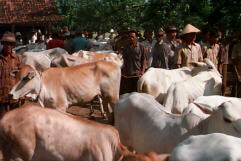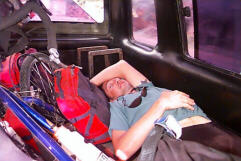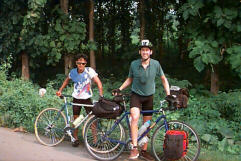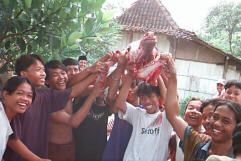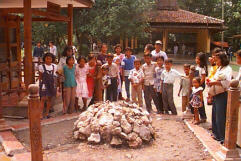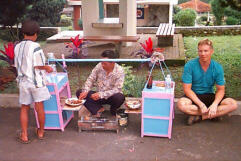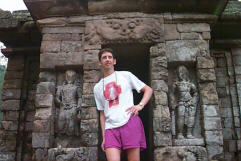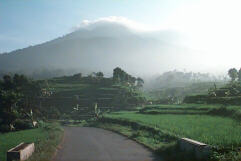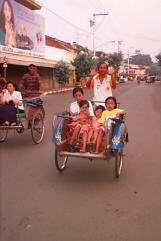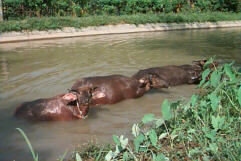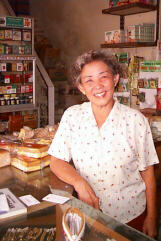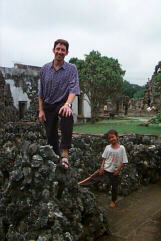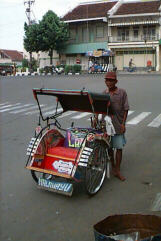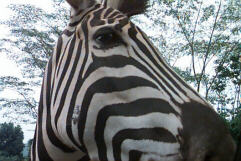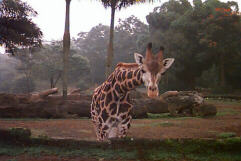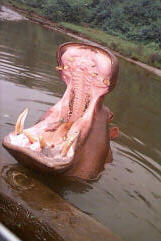| 1997 CALIFORNIA TO FLORIDA CA to AZ AZ to NM TX 1 TX 2 TX & LA LA, MS, & FL FL WESTERN EUROPE Spain & French Pyrenees France –Bordeaux & SW Coast 1 France –Bordeaux & SW Coast 2 France – Notre Dame des Cyclistes England Belgium & Holland Germany NORTHERN EUROPE Denmark Sweden Finland Estonia, Latvia, Lithuania EASTERN & SO. EUROPE Poland Slovakia and Hungary Croatia, Slovenia & Bosnia-Herzegevina MIDDLE EAST Turkey Cyprus Israel & the West Bank Zealot City Jerusalem Syndrome Jordan Egypt 1998 OTHER VOYAGES |
TRIPLOGUE Indonesia III: Central Java
It’s a pity Fred wasn’t feeling well enough to enjoy the sublimity that was this morning’s ride. We got an early enough start to see Javanese life at its liveliest and most serene. Mornings are the active part of the day here, and everyone seems to be in a good mood, smiling and enjoying the fleeting coolness in the air. Bikes were everywhere, many carrying huge loads of bamboo, rice, or rolling restaurants. We even saw goats riding in becaks. A blissfully shaded back road took us through Tuban’s prosperous-looking suburbs and the nearby market town of Merakurak, where the road became rougher but quieter, leading straight through a giant cement factory in the middle of nowhere. Fred and I wondered how they got the cement out, since no trucks or trains were in evidence. The small village of Kerek was thronged with people and animals in town for a huge market of cows and cow accessories. I practically had to push my way inside to get a photo and talk to some of the farmers. Most were standing around with one or two animals, asking about $75 per head. Another 25 kilometers of bumpity quiet roads and rolling pastoral splendor brought us to the main coastal highway. It was sort of a shock to see buses and trucks again, but the road had an excellent surface and was unusually wide. As the day wore on, the sun became more and more of an issue for both of us. The antibiotics I’ve been taking make my skin increasingly sun-sensitive, and Fred was all clammy and pale, looking like he might pass out. Together, we made a pretty good impression of the red-and-white flag of Indonesia. Rather than continue along the increasingly busy road (we tried finding an alternate route at one point, but everyone we asked assured us it didn’t exist), we opted for what has lately become a BikeBrats tradition: we chartered a truck to take us the forty-four kilometers to Lasem. Indonesians don’t like being alone; as with every other vehicle we’d chartered here, this rusty bucket of bolts included a very talkative driver plus his silent underling. With Fred sleeping in back with the bikes, I rode in front, sandwiched between the truck dudes. As well as posing the usual questions (Are the cars this ugly in your country? How many slaves do you have?) the driver provided me with a number of interesting insights. I learned that gas costs only 700 rupiah per liter (less than 35 US cents per gallon, at today’s exchange rate), yet transport dudes like him were lucky to net 5,000 per day. I also learned that the next day was a national holiday. "An Islamic holiday?" I asked. "Yeah," replied the loquacious driver, "it’s an important one, where everyone cuts up animals. You know, victims." When we passed through a scruffy-looking town called Kragan, he commented that there were lots of naughty children (anak-anak nakal) here. "What do you mean?" I asked. "Well, a couple of months ago –with the monetary crisis and all— they ran amok and trashed all the shops here. Some people got hurt." (It should be noted here that "amok", along with "orangutan", "bamboo" and "ketchup", is one of the few English words borrowed from Indo-Malay). I wondered aloud whether people would be running amok today, with the weekend’s announcement that seven banks had been dissolved and seven more had been put under government control. After a few moments of deep contemplation came the driver’s blithe response: "Maybe." We were deposited right in front of a bank in central Lasem. While there were certainly a lot of customers milling about (and you can bet none of them were making deposits), there was no sign of anyone running amok –much to our relief. We found refuge in the air-conditioned comfort of an American-style fried chicken restaurant where, as usual, we were the only customers. A subsequent poke around town revealed Lasem to be much less charming than Tuban, and we made a hasty decision to head straight for Kudus, the next big town. Since the only road there was the busy highway, we’d be chartering, of course. Our usual luck at finding transport gave out here, however. We rode back and forth through the town until we felt conspicuously dorky. No vans were to be found at the bus terminal, where a sleazoid character said he could help us out. Preferring not to deal with greasy middlemen, Fred and I elected to try in the next town, only 13km away on a nasty nasty road. Rembang looked and felt a lot more prosperous than Lasem, but we stuck to our plan to motor to Kudus anyway. The small yellow Daihatsu van that took us there had a crew of three this time, and the driver was less talkative than pressed for time, often passing imprudently. I held my breath most of the sixty kilometers to Kudus while Fred snored away in back. Off-loading our bikes in what our driver insisted was central Kudus (even though the landscape was still dotted with rice fields), a cyclist materialized out of nowhere. –Not your average Indonesian cyclist, either. He wasn’t a wizened old dude in a haji hat and sarong, kretek hanging out of his mouth, feet barely pushing the pedals of his rusty old Dutch-style three-speed. Rather, Santoso was decked out in lycra, riding an Italian racing bike with –incredibly—clipless pedals. Through a maze of smog-choked streets, he led us to our hotel and proposed we meet the following morning so he could ride along with us. We both wondered if this would be a good idea, given Santoso’s peculiar riding style (i.e. very slow, in a very low gear) yet agreed anyway, if only for novelty’s sake. Kudus didn’t strike us as a particularly charming town. The air was unbreathable and the streets uncrossable. It is famous for being the center for kretek (clove cigarettes) production as well as one of the first enclaves of Islam in the region. In the fading, diffuse light of late sore, we walked past streetside sate stands and a bustling commercial area full of gold shops to the old part of town, arriving at an ancient mosque during the call to prayer. The mosque had obviously been a Hindu temple many centuries ago and had some beautiful old carvings and a Balinese-looking belltower. We tried visiting the tomb of a saint behind the mosque but were shooed away, just as we had been in a similar place in Surabaya. Muslims apparently don’t appreciate having their holy places being defiled by infidels. More Islamic fun was to be had back at our hotel, where we turned on the t.v. to find every channel co-opted by a message from Indonesia’s Minister of Religion, who advised not to cut up so many animals as usual due to the monetary crisis (I’m not kidding). Then we were treated to images of Suharto and his very wealthy family praying in a mosque, or rather in an air-conditioned, bullet-proof aquarium inside a mosque. Outside, loud wailing and chanting filled the air into the wee hours. I fell asleep wondering if we’d get to see any goat-cutting action the next day.
Kerek's happening cattle market Attentively guarding the bikes
7 April, Kudus to Bandungan, 90km (f) Sleeping on the eve of the goat-cutting holiday was difficult at best. I felt marginally better than the day before, but somehow could not settle comfortably in my bed. It didn’t help that there was a constant moaning and crying noise being broadcast from every mosque all night. The noise was vaguely the sound you’d make falling out of a hundred story building over and over again. When the call to prayer sounded at 4:30 a.m. I had the sense that I hadn’t slept at all. I spent the next hour and a half milling about the room generally annoying Andy while waiting for our breakfast. I was a little worried, my lack of appetite from a few days ago had re-emerged and I had trouble getting my nasi goreng down my pipes. As we stepped out of the hotel Santoso was dutifully waiting for us. We began to pedal out of town with Santoso in the lead. Still Santoso was pedaling as 100+ revolutions per minute in a very low gear. Finally I had to pass him at Andy’s insistence in order to step up our pace. Santoso, unwilling to let a "guest" lead, re-passed me, finally shifting into a more reasonable gear. Thereafter much of the morning was a straight road along a massive dike. Houses with steeply pitched roofs and intricately carved peaks with mother of pearl inlay lined the road. When we stopped to photograph an especially elaborate house with intricately carved teak shutters and doors Santoso told us it was similar to his house. Somehow Santoso didn’t understand our itinerary and we missed our turn-off towards Bandungan. We had to backtrack over a very bad stretch of road. Santoso’s bike was ill-suited for such a ride. We stopped for a drink in a medium-sized village where we became, as usual, the main attraction of the day. Fortunately we had Santoso with us, so he managed to answer the six or seven standard questions for us as newcomers came to ask about us. Santoso had to turn back to Kudus after our refreshment stop. I almost wished I was going back as well, the afternoon was where we’d do all of our climbing. In the short-term the road remained flat to gradually uphill. We passed a little mosque where a frenzy of meat cutting was going on. Andy grabbed the camera and began to shoot photos of kids and adults abusing a cow carcass. At last we see the festival in action. Rather, Andy did, my stomach still to dodgy to look on. Huge road signs indicated that there was another "Tourist Object" that had to be seen. The "Eternal Flame" was basically a hole in the earth that natural gas leaked from that had been covered by rocks and lit on fire. A crowd of Indonesians stood by and watched it burn. Occasionally someone tossed their entrance ticket on the pile of rocks and watched it burn. This was substantially less exciting than the boiling mud in New Zealand. The hills became more challenging and I was overheating again as the thermometer pushed towards 100 degrees Fahrenheit at 11 in the morning. I was ready to stop and rest; Andy wanted to push onward. We stopped and ate some noodles at a warung and attempted to negotiate transport for me up the hill. In the end Andy decided to join me, not wanting to ride in the midday sun. It turned out to be a good decision because the next town was twice as far as we thought and the road far steeper in stretches. Our negotiation took far longer than we’d have liked, complicated by the driver’s demand for far too much money. The next 20 kilometers were some of the most rewarding in Java. From Salatiga we rode (mostly coasted for the first 7km) until we reached Lake Rawapening. The temperature was cooler from the altitude (500 meters) and the sun was completely obstructed by the black clouds that gathered over the mountain looming above us. We arrived in Ambarawa just as the clouds looked most pregnant. I was hoping for rain if not just to clear the smoke-filled air. We visited the railway museum where they had an impressive collection of derelict steam engines arranged around an old station. An ancient Javanese man who was the custodian of the museum seemed deeply disappointed that we couldn’t speak Dutch. Still he showed us some of the prize objects of the museum including an actual phone from America. Our favorite exhibit was, of course, the pedal-powered rail car. The next (not-so) difficult decision was: should we ride or transport up the next 500 vertical meters to the hill station at Bandungan? We found a pickup truck and negotiated a good deal by pitting one driver against another. When we arrived in Bandungan it felt like another planet. For the first time in weeks I wasn’t sweating. Above us hovered an enormous volcano and below us hung the haze-choked lowlands.
Santosa the magnificent A meaty sacrifice in the name of Allah Fascinating flamer
8-9 April, Bandungan (a) At first glance, Bandungan doesn’t look like much –just a ramshackle collection of wooden shacks and tacky concrete hotels clinging to the steep-sloped side of a mountain. Our own lodgings were of very dubious taste –a concrete fantasyland set in an Indonesian-style garden, complete with an aviary, color-coded tennis courts and a bewildering open-air amphitheater. We splurged (nearly ten dollars) and rented a condo-like substance, with numerous rooms on three levels and several outdoor areas looking out onto the view we never saw (due to the continuing haze from rice-burning). One day of relaxing and HTML-ing in the cool mountain air turned to two and could easily have been extended beyond that. At breakfast the first day we met a pair of standoffish Americans, Stan and Janet. They had just completed a stint of organizing an educational program for American students in Yogyakarta and were chilling (literally) for a few days before heading back to Michigan. Not your typical American couple, they told us how they’d lived in Vietnam for a few years yet were curiously vague when queried about the details. CIA? Neither Fred nor I thought so, since the older couple had a distinctly Christian bearing. Our suspicions were confirmed the following day when we ran into them at Gedung Songo, an 8th century Hindu temple complex nearby. Walking back to "town" with them, we learned that the program they had organized in Yogya was through a Mennonite college, and that their work in Vietnam was through the Mennonite Mission. I chatted with Janet about Indonesian politics while Fred discussed Clinton with Stan, who apparently voiced some ultra-right views. Both of us were very careful not to offend, but as soon as we arrived back at our lodgings, our new friends beat a hasty retreat back to their room and were very careful to avoid us for the remainder of the day. Could they have been freaked out by any homovibes they picked up, or was it our general godless heathen tendencies? We’ll probably never know.
A late lunch with industrious Pak Giman Goaty "Pred" taking-in Gedung Songgo's baah-reliefs
10 April, Bandungan to Pekalongan, 86km (f) Hotel Regulations:
(Surprisingly Microsoft Word 97 found only one grammatical error in all of the above rules. Scared to think what it has let me get by with…) The call to prayer wailed at around 4:30 this morning and the sky began to glow eerily stars gleaming through the morning light. I stayed in bed in a half-sleep relishing the cool mountain air. An hour later I looked at my watch and crawled out from underneath the mosquito net to finish packing. Within a few moments of stirring, the houseboy came around with our morning tea which Andy and I shared on the balcony while eyeing the mountain rising above us. Somehow we managed to be on the road by just after six. It was our earliest departure in some time. We rolled across the mountain foothills zooming down steep inclines and cranking up sharp rises. The scenery was the most beautiful of the trip. So much so that as we essed along it was difficult to stay on the road for the distraction. Smoking volcanoes rose out of the mist in the distance, ultra-green rice paddy stepped up the foothills, huge jungle-y trees carpeted craggy terrain; all of this competed for our attentions along with the demanding relief of our route. When the sun finally crept above the mountains in the east and cast our shadows on the ground I was already sweating. For the first time in days I was beginning to feel in-synch with Indonesia again. It didn’t hurt that the constant dry cough and runny nose I’d been fighting were finally waning. Add to that the obvious enthusiasm people expressed for our presence today; the sum of the two made me happy to be on my bike. We passed a pickup truck full of produce and people no fewer than ten times in the first part of our journey. Each time the little overburdened truck that looked like a fruit bowl struggled by me as I pumped up a hill they’d shout encouraging words and make similar gestures. Soon the rolling-road gave way to a seldom-interrupted perilous brake-busting downhill. My hands were so tired from squeezing the levers when the road finally settled back into its rolling routine that I could no longer extend my fingers. Few stores or shops were open because of the holiday and it took some effort to find a restaurant to breakfast in. What we did find was a traditional Indonesian lunch counter. There the waitress was initially inattentive so we helped ourselves to the snacks laid out in bowls along the countertop. Our first experiment was less than successful. It was a little lump of rice wrapped in a banana leaf and soaked in something that smelled like rancid rice wine. Soon ice tea and nasi pecel (white rice with vegetables smothered in a peanut and red pepper sauce) arrived and we were sated. Though Andy claimed he felt fine under the bright morning sun I was feeling its effects. Neither of us felt so strong as to refuse the unsolicited generous offer of a road work crew to haul our bikes and us up out of a deep and steep valley. They only conveyed us some hundred meters up and we continued to climb vigorously for another 100 at the same grade (marking the first time that we’ve had to push our bikes on this trip)and then 200 at a much more gradual pace. By the time we reached Sukorejo at around eleven in the morning I’d had about as much as I could take. I eyed the map and found a town that would offer us a great launching point for our descent down to the coast and Pekalongan. Andy reluctantly agreed to the ride to Bandar. The hired truck demanded four dollars to take the bikes and us thirty-four kilometers, a price that seemed outrageous. We had to consider that the truck could take no passengers back and had to take a longer route to avoid the police due to the limitations of his permit. The circuitous route wound us down canyons, over raging brown rivers, through passes and past new rice. I half-dozed through part of the trip, having difficulty distinguishing my dreams from reality. Our driver relished the trip as much as we did and described for us the trip we’d have down the mountain to Pekalongan as enak, delicious. And it was scrumptious. The smooth road’s gradual incline and gentle curves whisked us down to the plain below. A glorious mistake put us on a quiet road to Pekalongan, avoiding the main road completely. We spilled into the flow of traffic dominated by people on shiny new blue bicycles and smattered with all types of human powered vehicles and the occasional motor vehicle. The closer we got to the center of town the more effort we spent avoiding slow moving becaks. Pekalongan moved at a distinctly Javanese pace, purposefully serene and slow. Everyone in town had a different idea how to find our hotel. Following each recommendation dutifully we had a splendid tour of the center of the town. One mosque we passed deserved a moment’s attention. Its minaret most closely resembled a lighthouse. After a late lunch near the spiritual beacon we set off to wander the Arab quarter’s market. Arriving too late to shop for batik we walked the town. We sat in awe of full (and large) families crowded onto every form of transportation cruising the city. Crossing the street by foot was difficult if one concentrated on the task. If I let myself hit the stride of a relaxed Javanese and the traffic seemed to part for me as the Red Sea did for Moses. I felt one with Java.
Central Java highlands Cruisin' in Pekalongan
11 April, Pekalongan to Slawi/Cirebon, 85km (a) We began the day with a rather feeble attempt at finding transport to Comal, some twenty kilometers down the main highway. When none magically appeared (as it usually has) we decided not to waste the precious fleeting moments of relatively cool air, bite the bullet, and give the Jakarta-Surabaya highway a shot. It turned out to be not so bad, with respectful traffic moving at a reasonably slow pace. Nevertheless, after an hour or so of breathing bus fumes, it felt good to turn off it onto a deliciously quiet side road along a Dutch-style canal. We wound our way through kampungs to scruffy Comal, the day’s first water stop. Out in the rice fields it was planting day. Hundreds of peasants were busy moving young rice sproutlings from their vivid-green carpet-beds into the main fields, spacing them carefully in the newly-tilled muck. Aided by a decent tailwind and the smooth surface of the empty road, we cruised across the immense coastal plain, conscious of the rapidly rising temperature. Our map showed only one road in this part of the world, yet in reality the whole plain was crisscrossed with minor thoroughfares and canals, and we were soon more or less lost. Asking for the road to Cirebon –still quite a ways off—brought blank looks, so we indicated that we wanted to go east. Just as it was starting to get really hot, our smooth road turned into cobblestones, leading to an old Dutch factory at quitting time. We were instructed by a wizened old man in a weird combination of police drag and a haji hat to follow a road resembling an ox track across a railroad bridge. "It’s just a regular road, but leads to an asphalt one," he apologized. The "regular road" was hell on our butts and our bikes, yet provided us with an insight into what most Indonesians have to endure every day of their lives. Other cyclists bounced along with us at an excruciatingly slow pace. More than once along this stretch, we considered turning back, but the instructions had been accurate: after a couple of kilometers of Baluran-esque hell we were rewarded with a gleaming ribbon of shiny black bitumen. Water break number two drew a large crowd of gawkers, as interested in our bikes as in our ability to consume copious quantities of beverages and snack foods. They told us that Cirebon was still a good ways off and I contemplated riding all the way, wanting to get the most out of our last day cycling on Java. Fred, meanwhile, was already committed to taking transport from the next big town, and it didn’t take long for him to win me over to his side. More than any previous day in this hot country, I was feeling the effects of riding under the blistering sun. An hour or so along a flat, stimulus-free road brought us to the bustling market town of Slawi. When no air-conditioned Chinese restaurant appeared along the route, I stopped to ask a becak driver for a lunch recommendation. He suggested a bakso (noodles with fish balls) place a little further down the road. It was a sweltering little hole of a place with noodles far inferior to the ones we had the previous night. Fred made the mistake of ordering something called es campur when he saw one appear at a neighboring table. The multi-hued concoction consisted of ice shavings, cream, chocolate syrup, bread, pineapple, strawberry jellybeans and a number of unidentified elements. We backtracked into Slawi’s main intersection to get water and possibly arrange transport. The friendly woman who ran the store insisted we sit down and brought us fruit. When informed of our origins, she told us that the woman who owned the gold shop across the street had children in Texas and that we should go by and see her. Sure enough, every time we looked across the becak-clogged street an energetic Chinese lady would motion wildly for us to come talk to her. Reluctantly, we headed over to meet her, and were pleasantly surprised. Using very passable English, the older woman introduced herself as Nyonya Rijeki, which means "Madame Lucky" --a perfect name for a bordello-owner in prewar Shanghai, I thought. She offered us drinks and pulled out a seemingly infinite supply of family photos. "This one, he live in Ft. Worth," she said, "and has a very good job. I already visit him a few times but now the tickets too expensive and no one buy gold anymore. Before, I do really good business; that’s how I paid for my kids’ educations and why they can all live overseas now. Slawi not a very good place. You boys need to careful. Don’t eat in Indonesian restaurants –so dirty. And there’s so much magic here. Many, many magics. And gangs too… For a ring they cut off your finger!" I responded to this last bit of unsolicited information by saying we’d had no problems and that we were protected by our own magical talismans. She went on to tell us how she had just bought dollars the previous day in anticipation of her next voyage to Texas, and I began to suspect that she had been provided by some divine source. We were down to our last rupiah and it was Saturday, and we had no idea how we’d survive the weekend. I cautiously asked if she was interested in buying any more dollars, and within moments Madame Lucky had her big safe open and was casually pulling out wads and wads of cash. The first and most pressing item of business taken care of, we asked Nyonya Rijeki if she had any ideas for finding transport into Cirebon. Immediately she pulled out her cell phone and barked into it. "I call my driver. He know someone can take you to Cirebon with truck. But maybe you have to wait …maybe an hour." We were then whisked back across the street, where Mme. Lucky’s daughter has another gold shop. The daughter had been schooled in Australia and spoke perfect English, but looked rather perplexed as to why two sweaty American cyclists were sitting in her shop. When an old toothless man in tattered clothes emerged from the back of the shop, Fred whispered to me in a pity-filled voice, "That man just sold his teeth for the gold." But then Madame Lucky introduced the dotty-looking gentleman as her cousin, who proceeded to ask me a series of questions in wonderfully clear Indonesian. After about ninety minutes, though, Senor Toothless and I had pretty much exhausted our conversational possibilities, and Fred and I wondered how we could gracefully bow out of our predicament and arrange our own transport. Just as we were about to make our move and hit the road, Mme. Lucky fluttered back across the street from her shop, informing us that our ride had shown up. "I think it’s best you put bicycle in box," she said, to which we groaned, remembering a number of unpleasant bike-boxing experiences. So we were delighted to find that "box" referred to the truck, a pick-up with a big fridge-looking box on top. The bikes fit inside easily, and soon we were on the road. The whole way to Cirebon I was thanking my lucky stars that we weren’t riding. The road was busy and narrow, and the thought of pedaling on it, being terrorized by the likes of our speed-crazed driver, made me cringe. After a while we pulled onto the main highway, much busier here than it had been this morning now that we were nearing Jakarta –exactly the nightmare road that I expected it to be. It was a miracle that we made it to Cirebon alive, even using a car. Once inside our surprisingly elegant room above Kentucky Fried Chicken, we were thrilled to find a proper shower, under which we scrubbed off several nasty layers of road grime. How Madame and Miss Lucky had been able treat us with such respect and hospitality in our filth-encrusted (and surely malodorous) state remains a mystery.
Wish I was there... Madame Lucky
12-13 April, Cirebon (f) The name of this town had always been uttered in the same breath as batik. I’d imagined this burgh to be as delicate and refined as the hand-drawn (tulis) fabrics that came from the region. What I found in its stead was a busy grimy little town whose traditional alun-alun (square) had been replaced by two enormous shopping malls. Our hotel sat next door to the central and older of the malls above the Kentucky Fried Chicken. We nicknamed the Penta Hotel immediately as the Hotel Ayam Goreng (fried chicken) and referred to it as such much to the amusement of Cirebonian becak drivers and to the horror of the hotel management. In all honesty I never "hit it off" with Cirebon despite its charms, which included a Wendy’s Hamburger restaurant, Swenson’s Ice Cream shop and the elegant newer Cirebon Mall which everyone assumed incorrectly was where we were staying. Transportation was the first problem we encountered in Cirebon. There are two means of conveyance in town, becak and bemo. Neither was very comfortable or convenient. Becaks in Cirebon were among the most festively decorated in Java and were something special to look at. I’d describe them as the pedal-powered equivalent to a low rider taxi. Dayglow patterns, intricate murals, fanciful script and swooping fenders made you stand out in a crowd any time you rode in them. Unfortunately the becaks were not as comfortable as they were beautiful. First and foremost the seats were too narrow to accommodate two persons comfortably so we had to commandeer a flotilla of two to go anywhere unless one of us was willing to sit forward in the seat while the other sat back. Even then it was an uncomfortable ride for both mainly because the low rider effect was achieved by tilting the "cab" portion of the becak precariously back so the seat was more like a recliner than a bench with a back. The angle of the seat forced the leaner to constantly slide back so the hips of both passengers felt the constraints of the width of the seat. Another compromise in comfort for the sake of form is the elimination of the springs that smooth out the ride. I’d already begun to dislike Cirebon on the way to the train station to book our passage to Jakarta when we found out we’d be staying an extra day. All the Sunday trains were habis (full or finished) and we’d have to wait to depart until the next day. At the time I didn’t hate Cirebon yet, so I reluctantly agreed to stay and extra day so we could shop for oleh-oleh (little gifts) for our family and hosts in Jakarta. On the way back to the hotel from the train station (this time in two becaks having learned our first transportation lesson and now sporting bruised hips) we got lost and ended up at the new mall instead of our hotel. We exploited the error and went to see the latest "Alien" movie that neither of us had managed to see in the States during our hiatus. During the film I spotted a funny translation that gave me some insight into Indonesian censorship (or was it merely a bad translation). Winona Ryder was described by one of the less sophisticated characters as "f___able", which the subtitle rendered as "baik-baik" or very good. During the movie the mall had undergone a transformation. Most of the stores --including the combination book, sporting goods, electronics and stationary mart-- had closed, leaving the mall-ways to the young and restless of Cirebon and environs. The upper gallery balconies were crowded with teen-to-twenties looking to see and be seen. We caused quite a stir being the only occidentals in the place. I’d never realized how noticeable we are in an Indonesian crowd until I saw myself in a photo of myself with them. Not only is our coloring substantially different, but we tower over everyone by a head or more, which is surprising because neither of us consider ourselves especially tall by American standards. As we passed, conversations stopped and heads turned. Of course we’d become accustomed to having this effect in little villages, but had never felt this conspicuous in a larger town. Within a few moments of walking around we’d been latched onto by someone who wanted to "practice his English" which is normally code for someone wanting to actually:
In this case I think that the person actually wanted to practice their language skills, but we’d become so used to unceremoniously blowing off folks who used this ruse to speak with us that we prematurely got rid of them. During our exchange we noticed that we were drawing the attentions of a particularly obvious group of young local queens. One was dressed in "paint-on" tight velvet trousers and matching waistcoat while another was donning an updated Buddy Holly look complete with rather clunky looking eyeglasses. The others were wearing less memorable costumes as they encircled us while the English-practicer engaged us. Velvet (as we aptly named tight trouser boy) had adopted the most ridiculous gait of anyone I’d ever seen. His hips had more movement than any wash cycle. Folks who passed too closely risked being hipped into the next dimension. Our next day in Cirebon was divided between batik shopping and tourism. Our initial forays into consumption were substantially thwarted by shop closures and shockingly un-commercial business operators. One shopkeeper was far more interested in watching soap operas than helping us. Finally we came upon some very nice merchandise in a little shops where we were clearly respected for our purchasing power. We opted to shop the first day and buy things the second. Later in the day we decided to check out a "pleasure garden" and the tomb of a Muslim cleric. On our way to the pleasure garden we had a little transportation nightmare. Somehow, coming out of the mall near our hotel, we’d been latched onto by what we thought was a bemo conductor. He guided us to a little bus, yelled the destination to passersby and "chatted us up" in an altogether too-familiar fashion. It didn’t take long to recognize the strong scent of alcohol on the young man’s breath or to realize that we didn’t want to be anywhere near him. Horror struck when he exited the bus at our stop and told us that he expected some rupiah for being our guide. I offered him bus fare to get lost. He retorted by demanding twice that amount. We withdrew all offers and walked away towards the tourist attraction with him drunkenly yelling after us. At the ticket office he made one last appeal to the guard there claiming we had deceived him. We asked that they call the police and they responded by paying him off. At the garden we began to realize that we were in a different Java than the one we’d begun to know. We wandered in the garden that appeared to be a Hindu temple that had undergone a hundred bad remodels over as many years. It was sort of a maze of stairwells and passages that led to nowhere, crawling with adolescent spooners and pre-adolescent waifs begging for money. Andy referred to the latter as mosquitoes in the comment book at the exit. Our next stop was to be the tomb. I still am not sure as to whether we’d actually found the tomb or not. On the bemo there an elderly Muslim adopted us and agreed to show us the site. Walking through the cemetery he disavowed knowledge of our origins to all he met there while we tried to avoid the hundreds of beggars masquerading as cemetery custodians. Here too children asking for money and crowded around us like gnats, making it difficult to walk without tramping on one of them. We were led to a monument that was not interesting to me at all. On the way out I caught one of the human insects trying to reach into my pocket which is when we decided to head back to our hotel and abandon being tourists in Cirebon. In the bus on the way back a woman told us that she was not from here (Cirebon) but "from Java". This perplexed me, even with my rather limited geographic abilities I could tell that Cirebon was attached to the landmass known as Java. Andy and the guidebook corrected this misperception. Central and Eastern Javanese are different people than the Sundanese who occupy Western Java. Sundanese are considered crass and crude and therefore not civilized enough to be Javanese. She reinforced that the behavior of the folks we’d met today was not representative of the Java I’d come to like.
Fred fends off flies Colorful Cirebon becak
14-16 April, Jakarta (f) My first experience in Jakarta was in the late seventies when I went to visit my aunt and uncle. They’d been living there while my uncle Earl was working with the Indonesian government on offshore gas drilling in the South China Sea. He and my aunt Anita had taken my mom and me to all of the tourist attractions in the area. I could hear the voice of my recently departed uncle when we went to the mountains outside of Jakarta explaining how tea was harvested. One of my favorite stories that he had told was "that the best coffee in the world was rumored to be brewed from the droppings of rats that lived in the coffee warehouses." I could scarcely turn around in Jakarta without somehow being reminded of him. Many changes had taken place in Jakarta since then. The city has truly grown up. There are high-rise buildings everywhere and grand boulevards and toll roads crisscross the town. Still there is a strange and wonderful feel to Jakarta. Andy describes it as "Los Angeles superimposed on a giant kampung." It is an apt description considering that a trip anywhere is just as likely to take you through a maze of little huts and houses as one of the imposing avenues of the city. The Indonesians call it the "big durian", comparing it to the treasured sweet but foul-smelling fruit native to the archipelago. If you can get past the odor there is much to be savored in Jakarta. Our friends Scott and Ubay played host to us here most graciously. Scott gave us use of his new car to go to the countryside with Ubay. There we went to a massive drive-thru zoo called the Taman Safari. I expected it to be a lame tourist destination but was shocked to find it one of the best zoo experiences ever. In the lion compound there were at least twenty hulking kitties stalking around ignoring the presence of our car. At least until we were near the exit. There we paused for a moment and two lions approached the car, one at the front and another around the back. The one in front began to lick and then chew the bumper of Scott’s new car. It had gnawed several big toothy holes in the bumper while Andy laughed nervously and Ubay sunk in his seat. We drove off before it could pounce on the car and do greater damage. Later twenty or so tigers were fascinated by the scent the lions had left on the car. They licked the chewed up parts enthusiastically when the park ranger drove up and noticed the damage the lions had done. He recognized the feline tooth marks and chased the tigers off. In three nights and two days I’d become attached to Ubay and Scott. It seemed too rushed to leave by boat to Sumatra when Thursday finally came, but we had tickets and were on our way.
|

